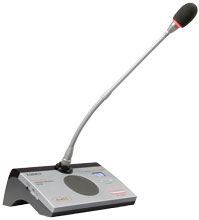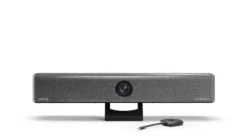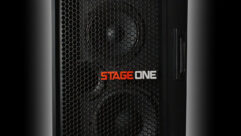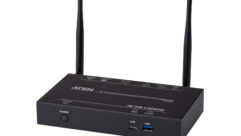

Media Vision USA Taiden HCS-5300 Wireless Conference System Review
Oct 18, 2012 2:28 PM, Reviewer: John McJunkin
A modular IR system for a variety of applications.
I have a client for whom I recently upgraded a conferencing system, including the introduction of handheld wireless mics. The budget was limited, so I initially specified fixed-frequency VHF units and carefully researched the white spaces to confirm that the systems would be in the clear. Indeed, the system has never suffered the interference typically associated with VHF—police, fire, government, etc.—but there were intermittent bursts of RF (a communications tone of some kind). I replaced the VHF units with UHF units, but the bursts continued. I realized that the light rail train that passed about 150ft. away from the rack housing the system had something to do with it. A potential solution was infrared because it brings all the benefits associated with wireless systems, but it sidesteps RF interference and licensing issues, and virtually eliminates eavesdropping and security issues. Although a lot more of my experience is in the RF domain, I have had exposure to IR, and I have always been impressed. I took a look at Media Vision USA’s Taiden HCS-5300 wireless conference system, and was pleased.
The system’s HCS-5302 mic units are modular to the extent that the microphone can be removed from the tabletop box. There are several versions available with voting options and a chairman unit that facilitates priority takeover. The front panel of the box is roughly the size of two stacked dollar bills. On the right of the unit is an LCD display that conveys battery strength, signal presence, and IR emission angle; a seesaw-type language channel control; the unit’s microphone on/off button, which is ringed with a two-color (blue/red) LED to indicate the mic’s status; and the power button. In the center of the tabletop box is its speaker and directly above that is the microphone jack. There are headphone jacks on either side of the unit, each with its own seesaw output-level control. There is a power inlet on the bottom of the box that accepts external power supply from a barrel-type connector. The unit’s battery pack also fits underneath. The front panel slopes gently upward, and the rear panel slopes downward a little more aggressively, and at the apex of both panels is the unit’s IR emitters and receivers under a transparent red bezel. The chairman and voting delegate units have their voting buttons on the left side of the front panel. The microphone that attaches to the tabletop is a cardioid electret condenser with a replaceable windscreen and a two-color (blue-red) LED ring to indicate its status. The stand supporting it features a gooseneck at the lower half and a rigid shaft at the top.
The HCS-5300M/20 main unit is intended for either tabletop or rack-mounted use, and serves as the nerve center for the system. The front panel’s left half features an LCD display conveying information about the system’s configuration and operation, along with four buttons for navigation through the system’s menus. There is also a power standby pushbutton and an 1/8in. jack for headphone monitoring. Moving to the right half of the front panel, knobs controlling line-in level and master volume are found, along with USB ports, and LEDs indicating the number of mics active and whether operation is open or in override mode, as established by the chairman. The rear panel’s left half features a 1/4in. balanced audio input, RJ-45 Ethernet jack, and the first three of six proprietary 6-pin DIN jacks that connect to the system’s IR transceivers and a BNC HF jack that connects to the TAIDEN IR Radiators for one way communication of system’s audio signal. Moving to the right half, there is an RS-232C port for optional control system, mic mix and line out XLR sockets, the other three DIN jacks for transceiver connection, Phoenix-type connectors for video switching, an IEC power inlet, and a rocker-style power switch.
The system’s HCS-5300TD central IR transceiver is a little more than 7in. in diameter, a silvery grey color, and studded with more transparent IR elements than I cared to count. The transceiver is shaped like a shallow inverted bowl, and at its top is a transparent red hemisphere, containing yet more IR elements and an LED indicating power status. There are several versions of this unit, and the one I evaluated is the one intended for ceiling mounting. It radiates a substantial amount of heat, and has ventilation openings on the bottom. There are also four slider switches on the bottom, corresponding to and toggling operation of the four quadrants of IR radiators on the unit.
The system was incredibly easy to set up and use. I plugged the transceiver into the main unit and placed the microphones around a boardroom table. I did not actually mount the transceiver on the ceiling, but I did suspend it in a location that approximated ceiling mounting. I powered up the main unit and gathered a group of professionals around the table for a meeting. I was impressed with the quality of the audio; the equalization and sensitivity of each microphone can be adjusted individually, which is a particularly useful feature if units are assigned to specific individuals who have preferences in terms of the way their unit sounds, or if it’s always used in the same physical location where there’s a troublesome frequency feeding back. There is an entire suite of software available to control the system, facilitating videoconferencing, recording, interpretation, voting, mic management, etc. I was very pleased overall with the simplicity of implementation and operation.
The system sounds very good, and works consistently and reliably. The voices of the people around the table were represented perfectly, clearly, and without interruption. I have been a fan of IR for this reason for a while, but having fought with both VHF and UHF recently, IR stood out in even more as a way to eliminate the difficulties.
As time goes on, we will only face more challenges from RF-oriented wireless, and it’s pretty obvious that IR will continue to gain popularity. We’ll also see improvements in IR technology, and I would submit that the Taiden system is high on the list of leaders in this domain. This technology is not inexpensive, but the quality, security, and elimination of RF-associated difficulty are well worth the expenditure. If you have the budget available and need a secure system with a substantial set of features and none of the struggles of RF, I recommend taking a look.
PRODUCT SUMMARY
Pros: Very simple set-up and use, eliminates RF issues, eliminates cabling in heritage sites
Cons: Comparatively expensive.
Applications: Boardrooms, confidential meetings, heritage sites, RF/Wi-Fi-heavy locations
Price: $1,050 (HCS-5302D); $4,000 (HCS-5300MC/20); $823.17 (HCS-5300TD)
SPECIFICATIONS
HCS-5302D Digital IR Wireless Conference Mic
Tabletop Unit
Dimensions (w/o microphone H x W x D): 68 x 180 x 132 mm
Weight:
Excluding battery: 0.46kg
Including battery: 0.78kg
Color: Silver/Charcoal gray
Frequency response: 20 Hz to 20 kHz (-3 dB)
Headphone load impedance: ≥16 Ω × 2
Headphone output: 10 mW
Microphone
Transducer: Electret-condenser
Polar pattern: Uni-directional
Sensitivity: -46 dBV/Pa
Frequency response: 50 Hz to 20 kHz
Directionality: 0°/180° >20 dB (1 kHz)
Equivalent noise: 20dBA (SPL)
Maximum SPL: 125dB (THD < 3%)
HCS-5300M/20 Digital Infrared Wireless Conference Main Unit
Frequency response: 20Hz to 20kHz (-3dB)
SNR: ≥80dBA
Dynamic range: ≥80dB
THD at 1kHz: ≤0.05%
Isolation: ≥80dB
Power supply:
America, Japan: AC 110V ~ 120V, 60Hz
Asia, Europe: AC 220V ~ 240V, 50Hz
Power consumption: Maximum 160W
Dimensions (HxWxD):
For table use, with feet: 99x430x325 mm
For 19” rack use, with brackets: 89x478x350 mm
Weight: .3kg
Color: White
HCS-5300TD Digital IR Transceiver
Wavelength: 870 nm
Modulation method: DQPSK
Carrier frequency: 2 ~ 8MHz
Voltage: 33V DC (from HCS-5300M)
Current consumption: Maximum 550 mA
Acceptance/emission angle:
Vertical: 150° (75°+75°)
Horizontal: 360°
Mounting: Ceiling, wall or tripod
Dimensions (diameter x height): 181mm x 63mm
Weight: 0.5kg
Color: Silver/Charcoal gray
John McJunkin is the principal of Avalon Podcasting in Chandler, Ariz., and produces and co-hosts a top-rated morning radio talk show in Phoenix. He has consulted in the development of studios and installations and provides high-quality podcast and voice production services.










